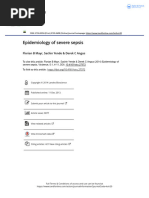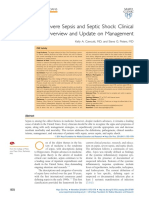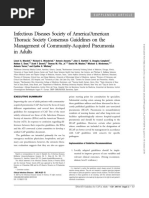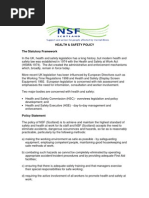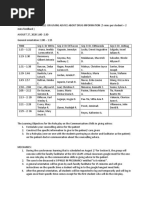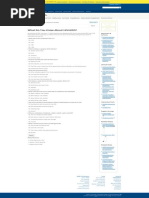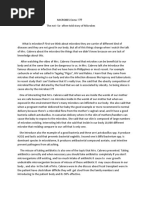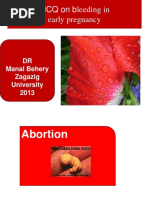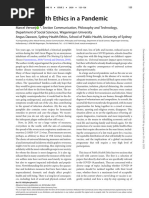National Institute For Health and Care Excellence Scope: 1 Guideline Title
National Institute For Health and Care Excellence Scope: 1 Guideline Title
Uploaded by
Rudy HartonoCopyright:
Available Formats
National Institute For Health and Care Excellence Scope: 1 Guideline Title
National Institute For Health and Care Excellence Scope: 1 Guideline Title
Uploaded by
Rudy HartonoOriginal Description:
Original Title
Copyright
Available Formats
Share this document
Did you find this document useful?
Is this content inappropriate?
Copyright:
Available Formats
National Institute For Health and Care Excellence Scope: 1 Guideline Title
National Institute For Health and Care Excellence Scope: 1 Guideline Title
Uploaded by
Rudy HartonoCopyright:
Available Formats
NATIONAL INSTITUTE FOR HEALTH AND
CARE EXCELLENCE
SCOPE
1 Guideline title
Sepsis: the recognition, diagnosis and management of severe sepsis
1.1 Short title
Sepsis
2 The remit
The Department of Health has asked NICE: ‘to produce a guideline on Sepsis:
the recognition, diagnosis and management of severe sepsis’.
3 Need for the guideline
3.1 Epidemiology
a) Sepsis is a clinical syndrome caused by the body's immune and
coagulation systems being switched on by the presence of an
infection (bacteria, viruses or fungi). Severe sepsis is defined as
organ dysfunction or tissue hypoperfusion (decreased blood flow)
in addition to sepsis, usually requiring a stay in an intensive care
unit (ICU). Septic shock is a life-threatening condition that is
characterised by low blood pressure despite adequate fluid
replacement in addition to organ dysfunction and sepsis. The UK
Sepsis Trust estimates that 37,000 people die from sepsis in the
UK every year.
b) According to the Parliamentary and Health Service Ombudsman
Annual Report (2013), the most common causes of severe sepsis
in adults are pneumonia, bowel perforation, urinary infection and
Sepsis final scope Page 1 of 15
severe skin infection. That report, based on example cases in
children and adults, recommended that guidelines were needed to
support the recognition and management of severe sepsis,
particularly in its early stages, and they should cover areas such as
initial recognition, timely use of antibiotics and fluid resuscitation.
3.2 Current practice
a) It can be difficult to identify cases of sepsis that need urgent
treatment to prevent progression to severe sepsis. The current
definitions of sepsis and severe sepsis were established in critical
care and paediatric critical care to define whether people were
eligible to join clinical trials. These definitions are used in
International Critical Care guidelines and provide a framework for
current intensive care management, but because sepsis is a
variable syndrome affecting 1 or more organ systems, the existing
critical care definitions and guidelines do not translate simply into
diagnostic pathways for initial diagnosis and management.
b) Current standard practice varies according to the clinical
experience of the physician or practitioner making the initial
assessment, and the facilities immediately available. In secondary
care, sepsis can present to any speciality involved in direct clinical
care. Groups that are particularly at risk of missed diagnosis of
sepsis are infants and young children, people who are
immunocompromised for any reason (including those being treated
for cancer), people who have recently had surgery, people with
indwelling medical lines or devices and women following childbirth.
These subgroups all have specific physiological factors that can
lead to a missed or delayed diagnosis of sepsis.
c) Treatment involves immediate recognition, resuscitation, early
treatment with antibiotics and continual monitoring and
reassessment. Although many current guidelines include the
assessment and management of sepsis in specific subgroups
within their remit, most do not provide guidance for all healthcare
Sepsis final scope Page 2 of 15
professionals in any situation to assess whether sepsis is present,
and to guide initial assessment and treatment.
d) This guideline will provide recommendations for recognising sepsis
and instituting treatment to prevent development of severe sepsis
and septic shock in any person in any clinical environment, linking
to other relevant existing NICE guidance. This guideline will not
replicate the existing International Guidelines for Management of
Severe Sepsis and Septic Shock: 2012, which cover the critical
care management of sepsis in children or adults.
4 The guideline
The guideline development process is described in detail on the NICE website
(see section 6, ‘Further information’).
This scope defines what the guideline will (and will not) examine, and what the
guideline developers will consider. The scope is based on the referral from the
Department of Health.
The areas that will be addressed by the guideline are described in the
following sections.
4.1 Population
4.1.1 Groups that will be covered
a)
Sepsis final scope Page 3 of 15
Group Rationale
All populations will be included. This guideline will include all
populations. There are a
number of different NICE
guidelines that may cover
aspects of recognition and
management of sepsis and
severe sepsis in subgroups of
the population. We will cross-
reference existing guidance
when it makes sepsis-specific
recommendations.
b) The following subgroups have been identified:
Group Rationale
Pregnant women People may be at higher risk of
People at higher risk of infection. sepsis when they have other
medical conditions. This
includes immunodeficiency from
various causes, for example,
treatment for cancer, people
with indwelling catheters or
devices and people who have
recently had surgery.
4.1.2 Groups that will not be covered
a) There are currently no groups that are excluded.
4.2 Setting
a) All healthcare settings.
Sepsis final scope Page 4 of 15
4.3 Management
4.3.1 Key issues that will be covered
(a) Recognition and early assessment of sepsis and severe sepsis:
clinical signs and symptoms.
Key clinical areas Rationale
Clinical risk assessment, Recognition of people at risk of
including history and severe sepsis allows
examination. appropriate treatment to be
‘Red flags’ for early started quickly and this is likely
identification of sepsis and to improve outcomes. Evidence
severe sepsis. indicates that delayed
Scoring tools. recognition of sepsis and severe
sepsis is common. Initial
assessment in primary and
community settings and on
hospital wards consists of
evaluating physical signs and
symptoms. Scoring systems
may be used to predict which
people are likely to develop
severe sepsis and/or to help
make a diagnosis in people with
sepsis or severe sepsis.
a) Value of blood markers for predicting and detecting sepsis and
severe sepsis.
Key clinical areas Rationale
Blood gas (arterial, venous or Early identification of sepsis
capillary). allows appropriate treatment to
Glucose. be started quickly. However, the
Sepsis final scope Page 5 of 15
Lactate. use of markers of infection can
Full blood count be misleading in sepsis as
(haemoglobin, platelets, white apparently normal test results
cell count and differential). (such as for white cell count)
Urea and electrolytes. may be associated with an
Clotting screen. overwhelmed immune response.
C-reactive protein (CRP). Blood markers may be useful
alone or in combination with
other tests. Consideration will
need to be given to the timing of
tests and the feasibility of
different tests in different
settings.
Sepsis final scope Page 6 of 15
b) Initial treatment for people with sepsis and with severe sepsis.
Key clinical issues Rationale
(i) Intravenous fluids and Sepsis can cause major
electrolytes in early systemic effects; severe sepsis
management of people with with clinical shock is the worst of
sepsis and with severe sepsis. these. The products of the
infecting organism (for example,
endotoxin or exotoxin) cause the
release and activation of
inflammatory mediators which
cause vasodilatation (the
widening of blood vessels) and
leakage from capillaries; this
leads to people becoming
hypovolemic (decreased blood
volume). The initial choice of
replacement fluid (that is,
crystalloid, colloid or albumin),
the timing of fluid treatment and
the amount to be given will need
to be considered.
Note: NICE has developed
guidelines on Intravenous fluid
therapy in adults in hospital
(CG174) and is developing
guidance on Intravenous fluids
therapy in children.
(ii) Empirical antimicrobial It is not always possible to
treatment strategies in early identify the cause of sepsis.
management of people with Early use of antibiotics is part of
sepsis and severe sepsis. the treatment for suspected
meningococcal disease in all
Sepsis final scope Page 7 of 15
healthcare settings, and advice
would be useful about how best
to use antibiotics in suspected
sepsis, due to any cause, in any
setting (for example, pre-
hospital treatment comparing
immediate broad spectrum
antibiotics to later targeted
treatment).
The incidence of different
causes of sepsis in different
populations and settings may be
an important consideration.
(iii) Early treatment with oxygen There is increasing reference in
and correcting the acid–base the literature to optimal early
balance in people with sepsis treatment being within shorter
and with severe sepsis. time frames than the previous
‘golden hour’. Correcting the
acid–base balance and the
delivery of oxygen may be
appropriate once sepsis is
suspected or has been
diagnosed.
c) Escalating care for people with sepsis or with severe sepsis.
Key clinical issue Rationale
Timing of escalation of care in The care of a person with sepsis
early management of sepsis. is a medical emergency and
Early treatment with inotropic their care should be directed by
agents in people with sepsis. senior specialists. The threshold
Sepsis final scope Page 8 of 15
Central venous access and at which senior health
arterial lines. professionals and/or critical care
providers should be involved
and central arterial or central
venous access is needed will be
considered.
Inotropic drugs may be indicated
for sepsis, and their use
considered as soon as severe
sepsis is suspected.
d) Identifying the source of infection.
Key clinical issues Rationale
The use of clinical symptoms Identifying the source of
and signs to identify the source infection will allow treatment to
of infection. be targeted in the management
Tests, for example: pathway. This may need
- blood culture appropriate healthcare staff
- lumbar puncture (clear (see 4.3.1.(d)) such as
contraindication criteria for obstetricians and surgeons to
lumbar puncture) be involved early on,
- chest X-ray and other depending on the clinical
imaging. presentation. There may also
be a need for prompt surgical
treatment.
Some investigations such as
lumbar puncture may be
contraindicated.
Sepsis final scope Page 9 of 15
e) Early monitoring of people with sepsis.
Key clinical issue Rationale
What parameters to continually People with sepsis or suspected
assess, how often and by whom, sepsis can deteriorate quickly,
for example: and appropriate monitoring can
identify this deterioration and
heart rate
detect response to treatment.
respiratory rate
blood pressure
blood gases
other blood markers, for
example, lactate.
f) Information and support for patients and carers.
Key clinical area Rationale
Information and support. Information and support is
needed for:
people with sepsis or severe
sepsis
people who are diagnosed as
not having sepsis and are
discharged from medical care
families and carers of people
who have sepsis or severe
sepsis
people who survive episodes
of severe sepsis.
Sepsis final scope Page 10 of 15
g) Training and education.
Key clinical area Rationale
All healthcare providers. Evidence indicates that sepsis is
often not suspected or
recognised. For some
healthcare professionals the
care of a person with severe
sepsis will be an unusual event,
but their suspicion of the
diagnosis may be critical for that
person.
4.3.2 Issues that will not be covered
Key clinical areas Rationale
(i) Procalcitonin. Assessment commissioned from
NICE Diagnostics Assessment
Programme.
(ii) Managing sepsis in This is a specialist area for which
neonates, children and adults in speciality guidelines already
the ICU. exist.
Specialist treatments of
conditions that result from sepsis
and experimental interventions
within the ICU will also be
excluded. These may include:
blood products
corticosteroids
supportive therapies
treating sepsis caused by
ventilator-associated
Sepsis final scope Page 11 of 15
pneumonia
neuromuscular blockade
renal replacement therapy
venous thromboembolism
prophylaxis
pressure ulcers
glucose control
immunoglobulins.
(iii) Treatment and care of Sepsis can lead to multisystem
secondary effects on other failure; however, managing this
organs. requires specialist ICU care,
which we propose is excluded.
(iv) Preventing sepsis. The guideline will not cover
measures to prevent sepsis.
This includes vaccination
programmes; infection control
and prevention measures;
personal protective equipment;
use of particular types of
catheters/feeding tubes;
preventing sepsis arising from,
for example, mechanical
ventilation or surgery; antibiotic
prophylaxis to prevent infection;
screening for pathogens in at-risk
populations.
Sepsis final scope Page 12 of 15
4.4 Main outcomes
a) Mortality.
b) Progression to severe sepsis.
c) Duration of hospital stay.
d) Duration of ICU stay.
e) Number of organs supported.
f) Change in physical signs and symptoms.
g) Adverse events.
h) Health-related quality of life (for example, as assessed by SF-12 or
EQ-5D).
i) Psychological outcomes.
j) Outcomes indicating severity of long-term disability/rehabilitation
needs.
k) Patient-reported outcome measures.
4.5 Economic aspects
Developers will take into account both clinical and cost effectiveness when
making recommendations involving a choice between alternative
interventions. A review of the economic evidence will be conducted and
analyses will be carried out as appropriate. The preferred unit of effectiveness
is the quality-adjusted life year (QALY), and the costs considered will usually
be only from an NHS and personal social services (PSS) perspective. Further
detail on the methods can be found in The guidelines manual.
4.6 Status
4.6.1 Scope
This is the final scope.
Sepsis final scope Page 13 of 15
4.6.2 Timing
The development of the guideline will begin in July 2014.
5 Related NICE guidance
5.1 Published guidance
Acute kidney injury. NICE clinical guideline CG169 (2013).
Critical illness rehabilitation. NICE clinical guideline CG83 (2013).
Intravenous fluid therapy in adults in hospital. NICE clinical guideline
CG174 (2013).
Feverish illness in children. NICE clinical guideline CG160 (2013).
Patient experience in adult NHS services. NICE clinical guideline CG138
(2012).
Antibiotics for early-onset neonatal infection. NICE clinical guideline CG149
(2012).
Infection control. NICE clinical guideline CG139 (2012).
Neutropenic sepsis. NICE clinical guideline CG151 (2012).
Diabetic foot problems - inpatient management. NICE clinical guideline
CG119 (2011).
Bacterial meningitis and meningococcal septicaemia. NICE clinical
guideline CG102 (2010).
Chronic heart failure: Management of chronic heart failure in adults in
primary and secondary care. NICE clinical guideline CG108 (2010).
Venous thromboembolism - reducing the risk. NICE clinical guideline CG92
(2010).
Diarrhoea and vomiting in children under 5. NICE clinical guideline CG84
(2009).
Induction of labour. NICE clinical guideline CG70 (2008).
Intrapartum care. NICE clinical guideline CG55 (2008) (update due for
publication October 2014).
Surgical site infection. NICE clinical guideline CG74 (2008).
Acutely ill patients in hospital. NICE clinical guideline CG50 (2007).
Urinary tract infection in children. NICE clinical guideline CG54 (2007).
Sepsis final scope Page 14 of 15
Nutrition support in adults. NICE clinical guideline CG32 (2006).
Postnatal care. NICE clinical guideline CG37 (2006).
5.2 Guidance under development
NICE is currently developing the following related guidance (details available
from the NICE website):
Pneumonia. NICE clinical guideline. Publication expected December 2014.
Intravenous fluids therapy in children. NICE clinical guideline. Publication
expected October 2015.
Antimicrobial stewardship guideline. NICE medicines practice guideline.
Publication expected March 2015.
Acute medical emergency guideline. NICE clinical guideline. Publication
date to be confirmed.
6 Further information
Information on the guideline development process is provided in the following
documents, available from the NICE website:
How NICE clinical guidelines are developed: an overview for stakeholders
the public and the NHS: 5th edition
The guidelines manual.
Information on the progress of the guideline will also be available from the
NICE website.
Sepsis final scope Page 15 of 15
You might also like
- Nclex QuestionsDocument47 pagesNclex QuestionsJheanAlphonsineT.Means75% (8)
- Biomarkers in Sepsis A Current Review of New TechnologiesDocument7 pagesBiomarkers in Sepsis A Current Review of New Technologiesrleon746No ratings yet
- Early Identification and Treatment of SepsisDocument4 pagesEarly Identification and Treatment of SepsisAnonymous QPakSNNo ratings yet
- E000088 FullDocument6 pagesE000088 FulldiosasenoritaNo ratings yet
- Sepsis ACEP 2021Document19 pagesSepsis ACEP 2021RodrigoNo ratings yet
- Sepsis Key Insights, Future Directions, And Immediate Goals. a Review and Expert OpinionDocument7 pagesSepsis Key Insights, Future Directions, And Immediate Goals. a Review and Expert OpiniondraabigaildelahoyaNo ratings yet
- What Is New and Different in The 2021 Surviving Sepsis Campaign GuidelinesDocument5 pagesWhat Is New and Different in The 2021 Surviving Sepsis Campaign Guidelinesamanda.gomesNo ratings yet
- Bacterial Meningitis Guidelines IDSADocument18 pagesBacterial Meningitis Guidelines IDSAAldito GlasgowNo ratings yet
- 63 2023 Article 1028Document5 pages63 2023 Article 1028Ahmad FahroziNo ratings yet
- Maternal SepsisDocument15 pagesMaternal SepsiskorstufNo ratings yet
- Severe SepsisDocument8 pagesSevere SepsisKie SanNo ratings yet
- Epidemiology of Severe SepsisDocument9 pagesEpidemiology of Severe SepsisFajar SutrisnaNo ratings yet
- Sepsis, Pathophysiology and Clinical Management (BMJ, 2016)Document20 pagesSepsis, Pathophysiology and Clinical Management (BMJ, 2016)Juan Luis Nuñez AravenaNo ratings yet
- Piis0025619614006636 PDFDocument7 pagesPiis0025619614006636 PDFDeary DearyNo ratings yet
- Jurnal 2Document6 pagesJurnal 2tataNo ratings yet
- Early Care of Adults With Suspected Sepsis in The Emergency Department and Out-of-Hospital Environment: A Consensus-Based Task Force ReportDocument19 pagesEarly Care of Adults With Suspected Sepsis in The Emergency Department and Out-of-Hospital Environment: A Consensus-Based Task Force ReportAndrei PopescuNo ratings yet
- Sepsis Pathophysiology and Clinical ManagementDocument20 pagesSepsis Pathophysiology and Clinical Managementkartini ciatawiNo ratings yet
- Sepsis Manjo y Fisiopatología BMJ 2017Document20 pagesSepsis Manjo y Fisiopatología BMJ 2017Juanita MesaNo ratings yet
- Choque SépticoDocument12 pagesChoque Sépticoapi-3826574No ratings yet
- Chronic Medical Conditions and Risk of SepsisDocument7 pagesChronic Medical Conditions and Risk of SepsisMargarita RamirezNo ratings yet
- Chapter 127 - Sepsis Syndrome - Rosen's Emergency Medicine Concepts and Clinical Practice 10thDocument10 pagesChapter 127 - Sepsis Syndrome - Rosen's Emergency Medicine Concepts and Clinical Practice 10thAlex DegraciaNo ratings yet
- Practice Guidelines For The ManagementDocument18 pagesPractice Guidelines For The ManagementCristian David Serna MazoNo ratings yet
- Sepsis OverviewDocument45 pagesSepsis Overviewzul kandiNo ratings yet
- Preepsin As EarlyDocument11 pagesPreepsin As Earlyfaraz.mirza1No ratings yet
- Adult Sinusitis GuidelineDocument31 pagesAdult Sinusitis Guidelineralu33No ratings yet
- IDSA Guias Infeccion de Tejidos Blandos 2014 PDFDocument43 pagesIDSA Guias Infeccion de Tejidos Blandos 2014 PDFyonaNo ratings yet
- Artikel GayaDocument9 pagesArtikel Gayagaya11No ratings yet
- Meningitis Bacteriana IDSADocument18 pagesMeningitis Bacteriana IDSAMargarita TorresNo ratings yet
- IDSA Meningitis GuidelinesDocument18 pagesIDSA Meningitis GuidelinesSahid López GarcíaNo ratings yet
- Diagnosing Sepsis  The Role of Laboratory MedicineDocument22 pagesDiagnosing Sepsis  The Role of Laboratory MedicineMaria PintoNo ratings yet
- Sepsis 2021 A ReviewDocument9 pagesSepsis 2021 A ReviewvictorNo ratings yet
- Sepsis - and - Septic - Shock (SUBRAYADO)Document12 pagesSepsis - and - Septic - Shock (SUBRAYADO)DylanNo ratings yet
- Pediatric Sepsis in The Developing World: Niranjan Kissoon, Jonathan CarapetisDocument6 pagesPediatric Sepsis in The Developing World: Niranjan Kissoon, Jonathan CarapetisOana MariaNo ratings yet
- IDSA MeningitisDocument18 pagesIDSA MeningitisarmayaNo ratings yet
- ACG Clinical Guideline Diagnosis, Treatment, And.14Document21 pagesACG Clinical Guideline Diagnosis, Treatment, And.14Jeremy A H.L.No ratings yet
- NursingDocument11 pagesNursingTamara LopezNo ratings yet
- Thesis. FinalDocument29 pagesThesis. FinalDwi RahmawatiNo ratings yet
- CelullitisDocument43 pagesCelullitisann_1983No ratings yet
- Practice Guidelines For The Diagnosis IDSA 2014 Infecã Ã o de Partes MolesDocument43 pagesPractice Guidelines For The Diagnosis IDSA 2014 Infecã Ã o de Partes MolesRafael SuzukiNo ratings yet
- Bacaan UrosepsisDocument14 pagesBacaan Urosepsisizza rnNo ratings yet
- Urosepsis-Etiology, Diagnosis, and Treatment: Continuing Medical EducationDocument14 pagesUrosepsis-Etiology, Diagnosis, and Treatment: Continuing Medical EducationMuhammad Imam NoorNo ratings yet
- IDSA Guideline Practice Guidelines For The Diagnosis and Management of Skin and Soft Tissue Infections 2014 Update by The Infectious Diseases Society of AmericaDocument43 pagesIDSA Guideline Practice Guidelines For The Diagnosis and Management of Skin and Soft Tissue Infections 2014 Update by The Infectious Diseases Society of AmericaFreddy PanjaitanNo ratings yet
- cc2019b1 SampleDocument27 pagescc2019b1 SampletanjudinNo ratings yet
- society_of_critical_care_medicine_and_the.13-1Document17 pagessociety_of_critical_care_medicine_and_the.13-1Eliss PavlikNo ratings yet
- Idsa CapDocument46 pagesIdsa Capwalit ukhri mukrininNo ratings yet
- Campaign surviving sepsis 2021Document80 pagesCampaign surviving sepsis 2021ScribdTranslationsNo ratings yet
- Practice Guidelines For The Management of Bacterial MeningitisDocument18 pagesPractice Guidelines For The Management of Bacterial MeningitishomayoonNo ratings yet
- 1Document7 pages1Teyaa KimNo ratings yet
- Meningitis Idsa 2017Document32 pagesMeningitis Idsa 2017Karín Milagritos Sebastián AndradeNo ratings yet
- 2017 Practice Guidelines For Healthcare Associated Ventriculitis and MeningitisDocument32 pages2017 Practice Guidelines For Healthcare Associated Ventriculitis and MeningitisBassamNo ratings yet
- Sepsis For The Anaesthetist: M. E. NunnallyDocument8 pagesSepsis For The Anaesthetist: M. E. NunnallySucii Sekar NingrumNo ratings yet
- Burden Sepsis PIIS0012369222002549Document2 pagesBurden Sepsis PIIS0012369222002549Edward ChavezNo ratings yet
- Ciw 861Document32 pagesCiw 861Dr Vikas GuptaNo ratings yet
- Infection Complication in Cancer PatientsDocument18 pagesInfection Complication in Cancer PatientsTonny YuliantoNo ratings yet
- HealthcareTransformers 6DiagnosticsTrends CatalogDocument35 pagesHealthcareTransformers 6DiagnosticsTrends CatalogJune MuchiraNo ratings yet
- Sepsis CurrentDocument8 pagesSepsis CurrentfelipeNo ratings yet
- Referat Anestesi - Sepsis & Septic ShockDocument36 pagesReferat Anestesi - Sepsis & Septic ShockDimas Arsana PrayogaNo ratings yet
- A Comprehensive Exploration of Age-Related Cataracts and Ocular Well-beingFrom EverandA Comprehensive Exploration of Age-Related Cataracts and Ocular Well-beingNo ratings yet
- COVID-19 Mortality Review in Malaysia & Updates on Clinical Management of COVID-19From EverandCOVID-19 Mortality Review in Malaysia & Updates on Clinical Management of COVID-19No ratings yet
- Arachnoid Cysts: Comprehensive Guide to Causes, Symptoms, Diagnosis, and Advanced Treatments for Brain and Spinal HealthFrom EverandArachnoid Cysts: Comprehensive Guide to Causes, Symptoms, Diagnosis, and Advanced Treatments for Brain and Spinal HealthNo ratings yet
- Block AEFI RegistersDocument3 pagesBlock AEFI RegistersSimbakutty Venkataramanan100% (5)
- NSF (S) - Health and Safety PolicyDocument5 pagesNSF (S) - Health and Safety PolicysanusaidNo ratings yet
- Caribbean Studies IA 1Document11 pagesCaribbean Studies IA 1mario josephNo ratings yet
- Department of Education: Republic of The Philippines Region Iv - A CalabarzonDocument8 pagesDepartment of Education: Republic of The Philippines Region Iv - A CalabarzonChariscel ArandaNo ratings yet
- NP1Document5 pagesNP1Krizyl Joy MabansagNo ratings yet
- 34 121 1 PBDocument8 pages34 121 1 PBdaud edowaiNo ratings yet
- RITM Biorisk Management Office Interim Biosafety Guidelines For Laboratories Handling and Testing SARS-COV-2 (COVID 19) SpecimenDocument6 pagesRITM Biorisk Management Office Interim Biosafety Guidelines For Laboratories Handling and Testing SARS-COV-2 (COVID 19) SpecimenJe Ann Catherine FeliasNo ratings yet
- ANTIBIOTIKDocument1 pageANTIBIOTIKgung diahNo ratings yet
- For Skill AcquisitionDocument17 pagesFor Skill Acquisitiongregjefferson.cardinoNo ratings yet
- Mechanics For Role Play On Communication Skills For YL3 On August 27 and 28, 2020Document9 pagesMechanics For Role Play On Communication Skills For YL3 On August 27 and 28, 2020Imelda Lorenzette ArañaNo ratings yet
- Non Kepi Vaccines RevisedDocument28 pagesNon Kepi Vaccines Revisedokwadha simionNo ratings yet
- PSM Old Questions (UM 2,) : KZM (Final Part I, 6/2018)Document9 pagesPSM Old Questions (UM 2,) : KZM (Final Part I, 6/2018)Anonymous d1CGjMTiNo ratings yet
- Our Health During The PandemicDocument19 pagesOur Health During The PandemicNina BachoNo ratings yet
- Evidence-Based Approaches To Childhood Stunting in Low and Middle Income Countries: A Systematic ReviewDocument8 pagesEvidence-Based Approaches To Childhood Stunting in Low and Middle Income Countries: A Systematic ReviewANGELNo ratings yet
- LANSIADocument18 pagesLANSIAThynta Jullyant NhaNo ratings yet
- HIV - AIDS Quiz - Health Encyclopedia - University of Rochester Medical CenterDocument1 pageHIV - AIDS Quiz - Health Encyclopedia - University of Rochester Medical CenterWz bel DfNo ratings yet
- MBBR Moving Bed Biofilm Reactor MBBRDocument17 pagesMBBR Moving Bed Biofilm Reactor MBBRJuan Alberto Camarena MonroyNo ratings yet
- Reflection MicrobesDocument2 pagesReflection Microbesanon_48319817100% (1)
- History of HivDocument14 pagesHistory of HivFirdaus Al HafizNo ratings yet
- 2 CREDE GCP Beginner Webinar Lecture Notes 2023Document19 pages2 CREDE GCP Beginner Webinar Lecture Notes 2023kaylawilliam01No ratings yet
- La Pyramide AlimentaireDocument1 pageLa Pyramide AlimentaireAnna BellouNo ratings yet
- MCQ On Bleeding in Early Pregnancy: DR Manal Behery Zagazig University 2013Document36 pagesMCQ On Bleeding in Early Pregnancy: DR Manal Behery Zagazig University 2013joseph0% (1)
- Student Project Herpes Simplex Type 2 InfectionDocument15 pagesStudent Project Herpes Simplex Type 2 Infectiontiramisu cocoNo ratings yet
- Director Global Health Programs in USA Resume Chana RabinerDocument3 pagesDirector Global Health Programs in USA Resume Chana RabinerChanaRabinerNo ratings yet
- Verweij M. & Dawson A. 2020Document2 pagesVerweij M. & Dawson A. 2020kulee123No ratings yet
- Journal Ob SurgDocument2 pagesJournal Ob SurgDawnmurph Dharlene Wag-eNo ratings yet
- Pcol. Paul Kenneth T. LucasDocument4 pagesPcol. Paul Kenneth T. LucasVanessa Abaricio TigresNo ratings yet
- Moot PropositionDocument8 pagesMoot PropositionAmbuj SakiNo ratings yet
- In Partial Fulfillment of The Requirements For Practical Research 2Document18 pagesIn Partial Fulfillment of The Requirements For Practical Research 2Trisha Camille OrtegaNo ratings yet











